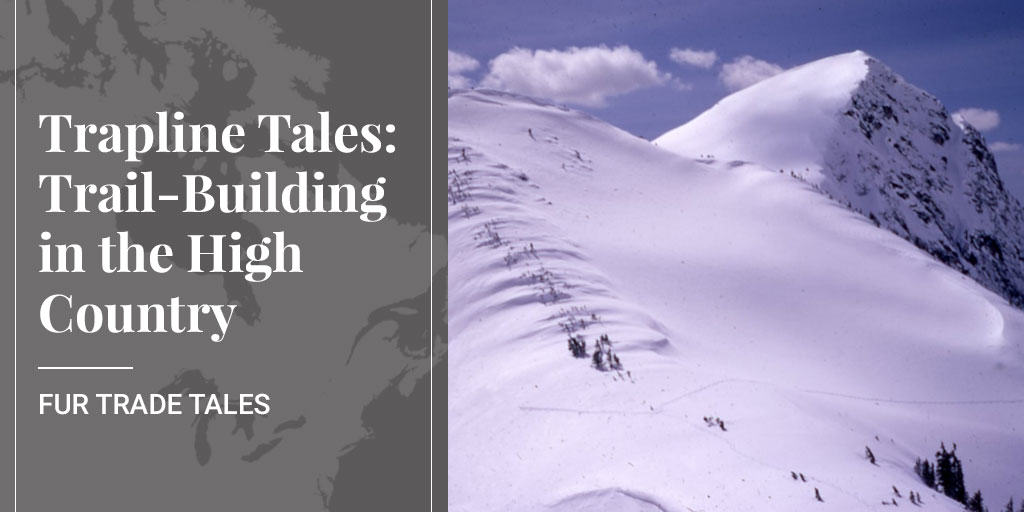
Welcome to Fur Trade Tales, our series of real-life stories from real people of the fur trade. This is our second Trapline Tales, but look out for Fur Farm Tales, Furrier Tales, and more to come. If you'd like to contribute, please let us know at [email protected]
As a teenager growing up in the Selkirk Mountains of British Columbia, trapping with my father in the high country was exciting and fun. He taught me to respect the animals we trapped because they gave their lives for our livelihood. For him, it wasn’t how many he caught, but how he caught them and in particular how humanely he could do so. He felt there had to be better methods of trapping and better tools than were on the market.
SEE ALSO: Trapline Tales: Ski doos and marten scent. By Calvin Kania.
While Dad pursued his dream of making a better mouse trap, I was more inclined to pursue the next marten or muskrat. I loved marten-trapping because we did it in the high alpine country. It was always a struggle to get there in January, with the steep inclines of the logging roads and the fresh powder snow, but it was worth it – pristine country, brisk, fresh, pure white and untouched, under a clear blue sky. We would find a big ole spruce or hemlock tree with the boughs drooping down to create shelter from the five feet of snow that lay around, then under the tree we’d build a fire and make a pot of tea.
But make no mistake, trapping in the high country is anything but easy. As you will hear in the tale I’m about to tell, it requires perseverance and stubborness.
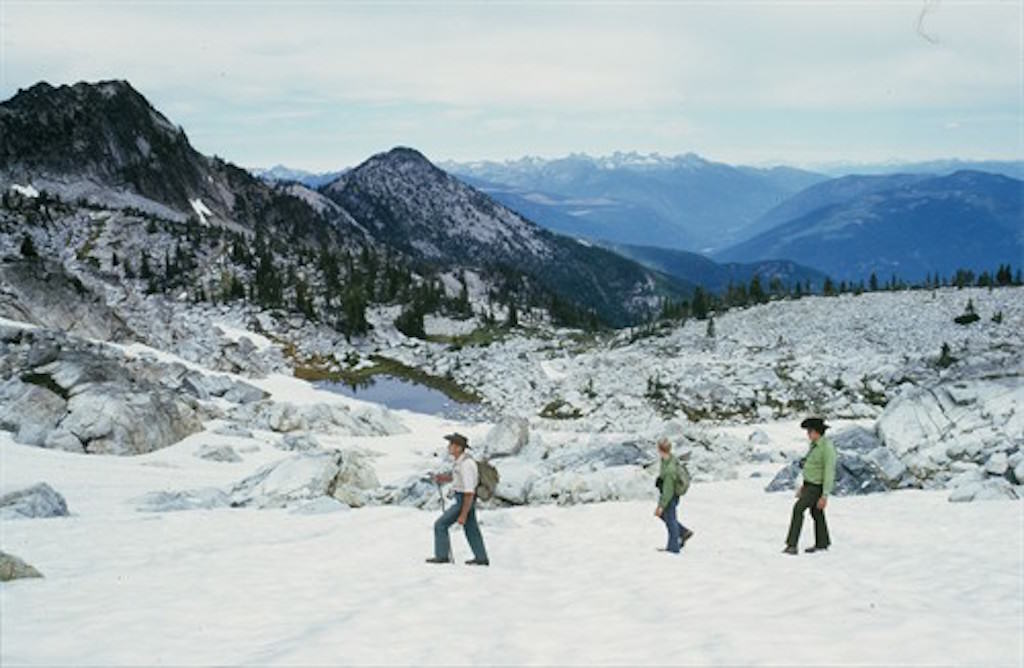
One Sunday in the summer of 1974, when I was 15, my parents and I headed up Airy Creek, a pristine area we had not trapped for five years, for berry picking and a fish fry. Picking berries has always been one of Mum’s favourite things, and along the way her eagle eyes were hard at work. “Stop the truck,” she cried. “I see some huckleberries!”
Now a few years earlier, she’d wanted to pick wild strawberries and dragged me along to help because that’s what kids were for in those days. Do you have any idea how small wild strawberries are? About the size of a small button on my golf shirt. So imagine how long it took to fill an ice cream pale. All day. So when Mum got excited about picking those huckleberries on her own, we stopped the truck right away. “Yep, no problem Mum! Way you go! See you later!”
Fish Fry
Dad and I then ventured on up the old logging road until we came to a spot where a bridge used to be. The timber company had not logged here since 1970, so they hadn’t kept up with road and bridge maintenance. Most logging roads in British Columbia are “de-activated” if the logging company is not intending to log the area again for some time, and with the total loss of this bridge, you could definitely say it was de-activated. The creeks here are not that big to traverse, but big enough to keep our truck and snowmobiles out when there’s no bridge. Anyway, Dad decided if we were going to trap into the head end of Airy Creek, we needed to find a way to cross it come winter time.
Since it snows very heavily in the Selkirk Mountains, it wouldn’t take much to make a bridge to hold a snowmobile. So we got busy cutting three good-size hemlock trees and fell them across the creek side by side. We then winched them up onto the road bed on both sides of the creek, and cabled them to some larger trees on the bank.
By this time it was getting late in the afternoon and Mum finally caught up to us with her bucket of freshly picked huckleberries. She looked around and asked where the fish were. “In the creek,” says Dad. “Are they cleaned yet?” “No, they’re still swimming around.” “Boy,” she says, “I send you two up here to catch some fish for supper and you’re fooling around with logs. Don’t you get enough of that around the farm? If I have to do your work and mine, so be it.” And off she went with her fly rod.
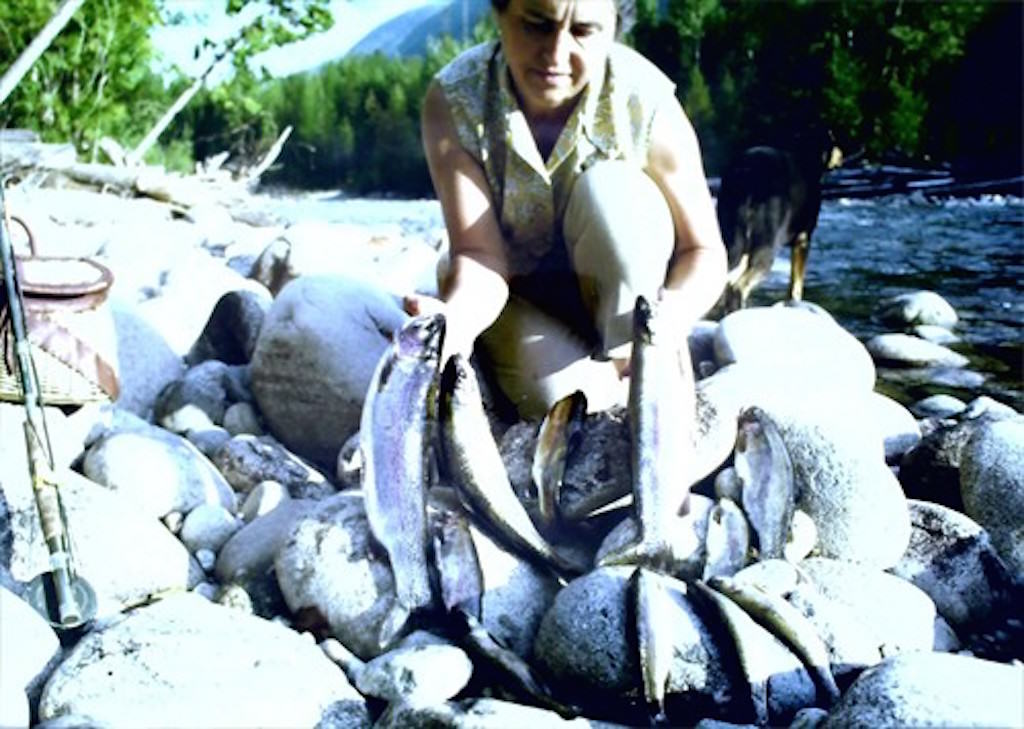
About an hour later she emerged with a few trout and saw no fire or tea pail boiling. Yep, we dropped everything in an instant and got on that fire and cleaned the fish!
Let me tell you, there is nothing better than a fish fry on an open fire on a beautiful summer afternoon. The fire is ready, the black cast-iron pan is hot, and half a pound of butter is thrown in to melt. The fish are gently laid in the pan, but before you know it, they curl up so fast. With fresh home-baked bread, tartar sauce, fresh cucumbers and tomatoes from the garden, those little trout tasted so good with our freshly boiled tea.
The day came to an end and we were all full of Mother Nature’s bounty.
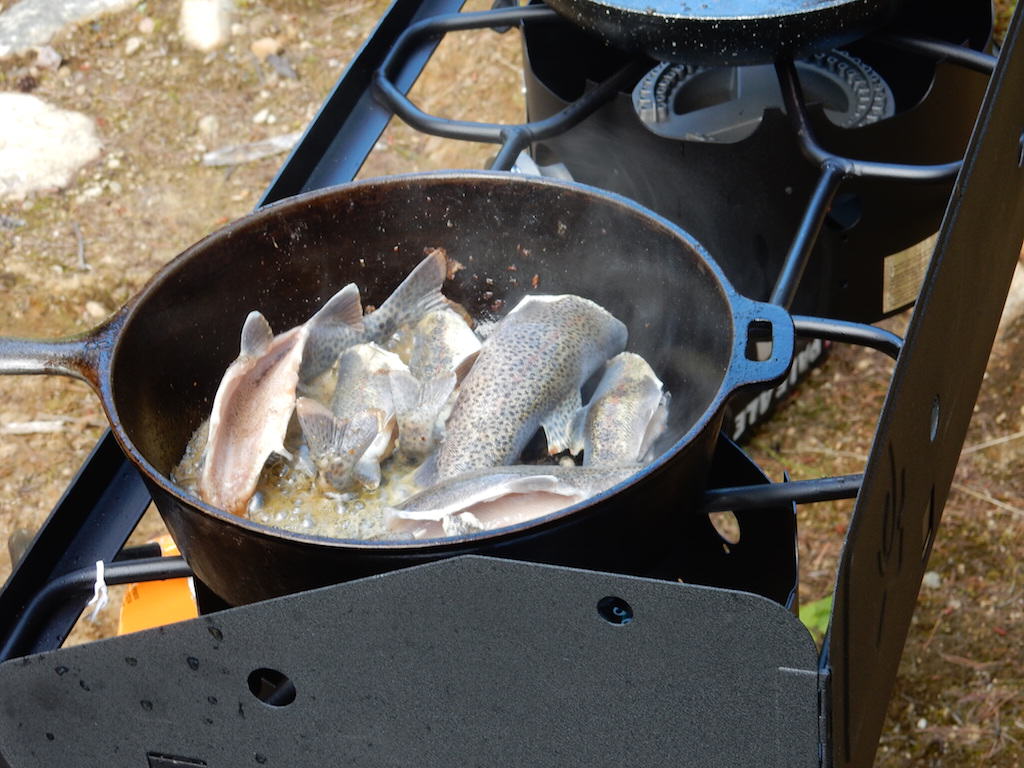
Bridge-Building
That fall, Dad and I drove up to check on our bridge, hauling along some 1×4 wood planks Dad had sawn up on his portable sawmill. The three timbers were still in place, and we laid the planks across them so they looked like a railroad track.
But those planks were still two feet apart from each other, so we spread some hemlock boughs across them. In this high country in winter, the snow falls gently in big flakes and accumulates very quickly. By the time we were ready to trap, there would be four feet of snow piled up on that makeshift bridge, and our snowmobiles would have no problem crossing.
We never trapped the high country until after Christmas. Snow in December came hard and fast, accumulating at two or three feet a week, and that made it almost impossible to break trail to check the line every few days. So we usually left it until mid-January when the snow eased up, started to settle, and gave us a good base to travel on.
Trapping Time
January was now here and it was time to trap some marten, lynx and wolverine up Airy Creek. I was so excited as we got our gear together – traps, bait, hatchets, nails, snowshoes, extra gas, and a sled to pull our supplies.
And for goodness sakes, we couldn’t forget our eau du toilet marten call scent (see recipe here). After all Mum had endured during our creation of this fine call scent, we’d darn well better not forget it! It was such a wonderful scent that it was stored in a quart jar with a lid and a very stiff 12-inch metal wire handle wrapped around the base of the lid for carrying. Even us trappers didn’t want to get any of it on our mitts or clothes!
With both snowmobiles mounted on the trailer – our vintage Bombardier and the newer Ski Doo Elan – and all the supplies loaded up, we started the truck and headed down the road. We reached our destination within half an hour because the logging company had kept the main road open. There we unloaded our equipment, fired up the snowmobiles and off we went, breaking trail over the old logging road.
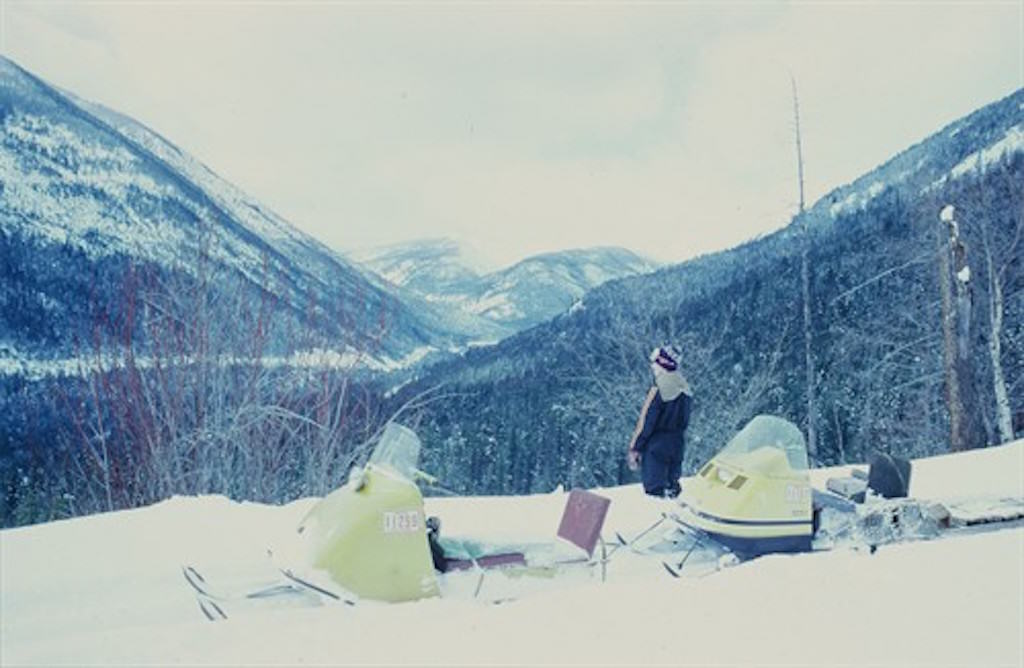
It was pretty easy at this point as most of the road bed was level. Then we started to climb, and the machines slowed as we were now pushing snow, but we finally reached our bridge without having to break out the snow shoes.
“Wow! Look at that bridge!” I yelled. It was a thing of beauty. At least four feet of snow was piled up on it and it had a bow in it, but not to worry, Dad said. We got out the snow shoes and carefully walked across, packing the snow so it would be easy for the snowmobiles to cross.
Dad went first with the Bombardier. It was smaller and lighter than the Ski Doo so it could stay on top of the snow better and was easier to break trail with. He fired it up, gunned it, and was across in no time.
Now it was my turn, and I was pulling the sled. “Don’t go so fast,” warned Dad. “If the sled slips off the bridge, you’ll be going with it into the creek.” Oh gee thanks, wasn’t that something to look forward to! I was also scared of heights even at that early age. “Don’t look down,” he said, “just straight ahead. When you get to this side you can gun it ’cause we have a steep hill ahead and we need as much traction as we can get before we bog down.”
I let him get a couple hundred yards past the bridge before I started across. “Don’t look down!” I kept telling myself, and lo and behold, I was across and feeling exhilarated. Now the work begins, I thought, because I knew those snow shoes were going to get a good workout breaking trail further up.
My machine was doing well because I was following in Dad’s broken trail. He was already out of sight around the first bend because we were not to stop. We were gaining elevation fast and had to break as much trail as we could. Then I came around the next bend and there he was, stopped! What the !? We hadn’t gone a quarter of a mile. “What happened to the road?” I asked. “There isn’t any,” he replied. “It’s down there at the bottom of the creek.”
Mega Project
All of our summer work, gone in a flash. There it was, no road, for all to see. Over the years since the timber company last logged there, one spring the creek must have been high and washed 100 yards of road entirely away. All that was left was a barren hillside of sand and gravel with a drop of 300 feet to the creek below. “Now what?” I asked. “I guess we just start building a makeshift trail across the hillside along the bank,” Dad said.
Well, if you think the bridge-building was a project, this was going to be a mega project. But first we had to build a trail under the trees that came off the hillside and piled up on this side of the road where it ended in mid-air. Of course it would have been a whole lot easier to have checked out this road last summer before we went to all the trouble of building a bridge.
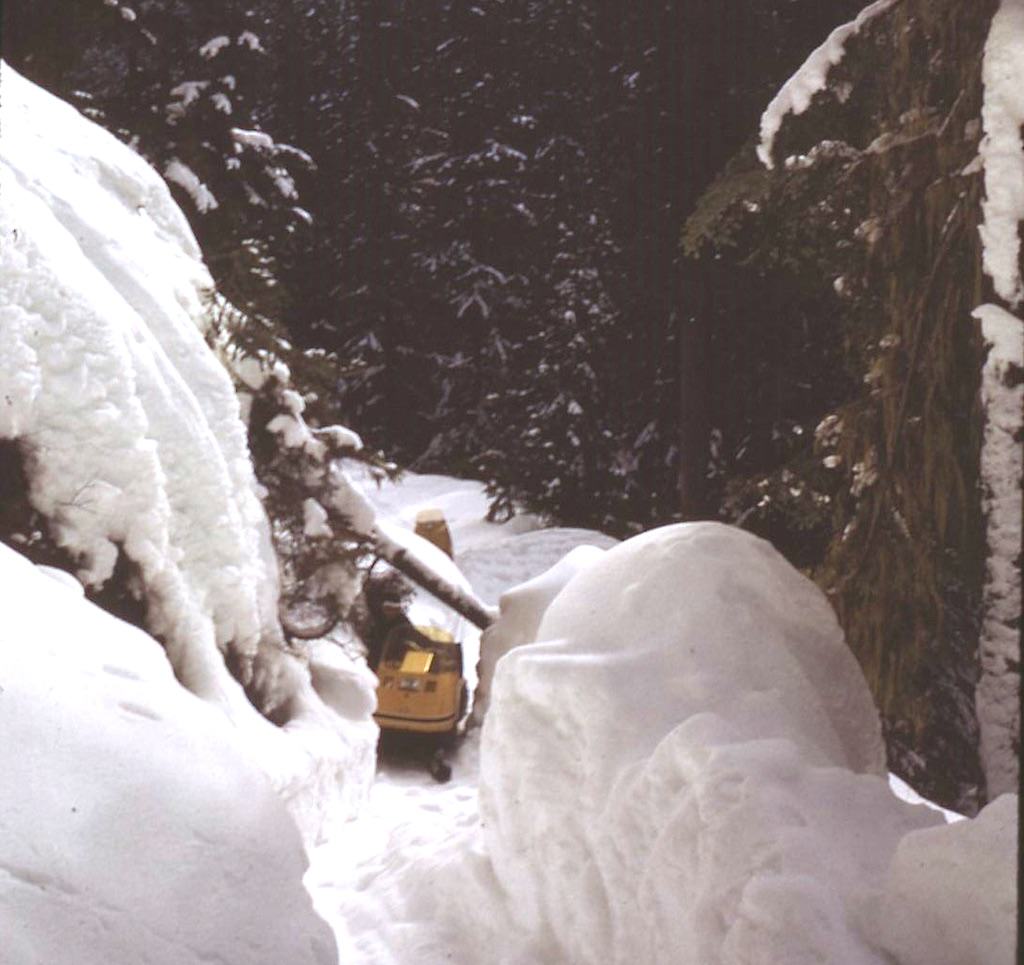
It took us all day to build a trail across that embankment. It was a good thing we always carried a snow shovel, and Dad knew a few things about road-building having worked on the Alaska Highway during World War II.
We decided to break some more trail before daylight ran out, but we’d only gone another half mile when I’ll be darned if we didn’t hit another washed-away road. We shook our heads in bewilderment. “We’ve come this far and done this much work,” said Dad. “There’s no turning back now. We’ll just come up tomorrow and work on this section.”
Well, we eventually found our way to the head of Airy Creek, and that winter caught 35 marten, two lynx and three wolverine. There were remnants of old logging camps scattered about, some going back to the 1940s, and an old collapsed cookhouse and bunk house were great locations for our lynx sets. No more washed-out roads, and our bridge held up through the season.
We did it for income, of course, and it helped that Dad knew how to stretch a penny. But we also did it for the love of trapping, and for simply being out there. And we couldn’t have done any of it without Dad’s perseverance and stubborness, qualities which he passed on to me and which have helped me survive close to 50 years in the fur trade.











Really great story. I started it thinking it would quickly scan it and move on, as I do for about 90% of online blogs that I peruse through during a web-browsing leisure session. However, that being said, before I knew it I was engrossed ii the story and read every word from the first to the last! It was engaging, interesting, and had a light, enjoyable tone that instantly transported me back to my own childhood growing up on our family farm on the Prairies. From how you write of your father, I got a clear sense of who he was and how much you admire and respect him. Same with your mother — who I think is the true unsung hero in this story and from the glimpse of her you showed us, I have a feeling that there is a woman that has depth and a strength of character that would have been the basis for many many adventures in her (and your) life. Thank you for sharing.
Loved this engaging tale about hiking & trapping in the high country of the Selkirk Mountains with your Mom and Dad. Your anecdotes about; the bridge & road building, the trout fishing & huckleberry picking and the tea under the spruce boughs bring the story to life, (not to mention the photos!).
Looking forward to more of the same.
Your stories are so enjoyable and give me a real feeling of how it was and who your dad was. You give him a hero like man. I look forward to more stories. Thanks.